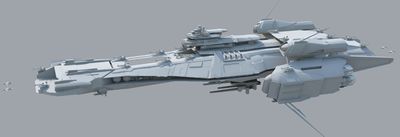
The Behring Applied Technology division stands in an interesting place: while its existence may have been one of the worst kept secrets in the galaxy, its overall reach and impact on military (and spin-off) technologies may never be truly known. The incorporation papers for the Behring weapons consortium make no mention of the division, press inquiries are ignored or dodged, and corporate org charts show no oversight …but a steady one quarter of the company’s profits vanish with every published budget.For years, all mention of the division was strictly forbidden. When pressed at a formal dinner, Evan Behring himself famously acknowledged that the division exists, but then claimed that they “develop next-generation home goods.” Today, the company acknowledges that BAT exists and that they are responsible for the heavy weaponry found on naval warships, but denies the budgetary implication that they have a much wider role in top-secret research.
Although BAT’s existence was formally denied, its effect was always widely felt and its role is widely recognized across the galaxy; after all, even before the admission, the massive laser weapons used by UEE ships-of-the-line had to come from somewhere. Thanks to the general collection of folklore and the overall passage of time, BAT’s long history, stretching back to the early days of spaceflight, is now well explored. The Behring consortium was founded in 2554, a combination of several dozen smaller research and development firms. This arrangement gave rise to the famed Terra laboratory responsible for standard laser weaponry and dozens of other Behring innovations. Quietly, though, it also birthed BAT. Initially hidden on a Terran moon (and now beneath the surface of Odin II’s moon, Vili), BAT was charged with meeting the needs of military black budget projects.BAT is known for its unflinching attitude toward experimentation and research; the scientists and engineers who compose the team have labored ceaselessly and loyally creating weapons of both conquest and defense across a variety of political landscapes.
To this day, it is difficult to say what innovations originate at BAT beyond the fact that the division must be responsible for much of the UEE’s capital-class naval weaponry. Certainly, Behring has taken no credit for weapons or other technologies developed there. It is none the less believed that BAT has developed the technologies of a wide variety of fields, the most obvious of which can be found in significant enhancements to shield, propulsion, laser mirroring, and remote sensing technologies. One thing that is widely known today is that the BAT division’s unofficial mascot is Barrie, a cartoon bat who has been lovingly painted on countless prototype killing machines.
Capital-Class Turrets
In particular, the Behring Applied Technology laboratory has been given credit for two types of high yield capital ship weaponry: Anti-Ship Artillery (ASA) weapons and Ship to Ship (STS) turret weapons. ASA turret mounts are designed, simply, to protect large ships from smaller ones. With lightning-quick hydraulics and integrated targeting interfaces, ASA turrets are generally sited in a ring around a capital ship’s hull to offer as full an arc of protection as possible. ASA turrets mount smaller yield laser weapons similar to those found on civilian spacecraft. The stock military Idris-M frigate, for instance, carries six ASA turrets that each mount a Behring M3C laser system.
Ship to Ship turrets are a much more powerful affair, designed to punch through the shields and hull of other large starships. Although they lack the quick reaction time of ASA turrets and so are generally unsuitable for flak coverage, their higher caliber weaponry will ensure that any hit against a fighter or bomber is likely deadly. Like their smaller cousins, STS turrets are modular and can be outfitted with a variety of individual guns. For example, the Idris-M corvette mounts a centerline STS ‘stinger’ turret featuring a Behring M5C laser cannon. The workhorse of the Navy, the Javelin destroyer, mounts a pair of Behring M6A laser cannons on STS turrets standard.
While the concern is responsible for manufacturing, antimatter yield coring, and other important processes in turret development, likely the most significant advancement they have been credited with is the development of the shield interphase kits that are now standard on all turrets. Prior to the 28th century, it was believed impossible to design a shield system that could operate with a rotating turret; where early shields were designed with ‘blind spots’ that could allow fixed cannons to fire out of a designated hardpoint, they lacked the ability to do the same with a gun whose position was impossible to predict before firing. Capital ships of an earlier era would need to drop their shields entirely before firing, which made arming with anti-spacecraft weaponry impractical. With BAT’s interphase kits, almost anything can be shot out from within a standard shield.
Rail Guns
What would you do if you had the biggest gun in the galaxy? BAT offers the opportunity to answer that question in the form of their massive 130mm “Ship Buster” rail gun system. The most powerful single-charge rail gun in known space, a hit from a Ship Buster is capable of smashing a destroyer as though it were a tin can. A single Ship Buster forms the keel mount of the Bengal carrier, while a series of the weapons forms the fighting power of the Retribution-class. These rail guns use the same technologies as standard fighter-based mass drivers, on a massive scale once thought impossible to achieve. Series of thousands and thousands of charged electromagnets generate the power needed to throw the 130mm slugs.
Black Ops
It seems undeniable that BAT is heavily involved in black ops research. Recent advancements in remote sensing, automated camo and jointed thruster technologies have likely sprung from Behring’s top secret labs. Although this will never be formally confirmed, the trillions of UEC funneled into the research efforts within Vili’s core could retrofit the standing navy’s wide caliber lasers a dozen times over. More horrific rumors imply that BAT is responsible for biological warfare research. There is clear evidence that a number of eminent xenobiologists have ‘gone grey’ and disappeared into the black ops wing of the military. Whether or not the fringe claims are accurate that they are taking part in the vivisection of Vanduul prisoners of war is less clear.


